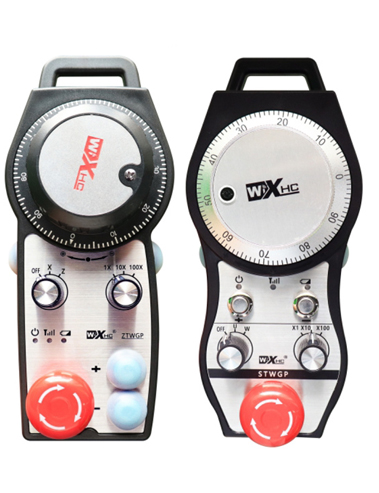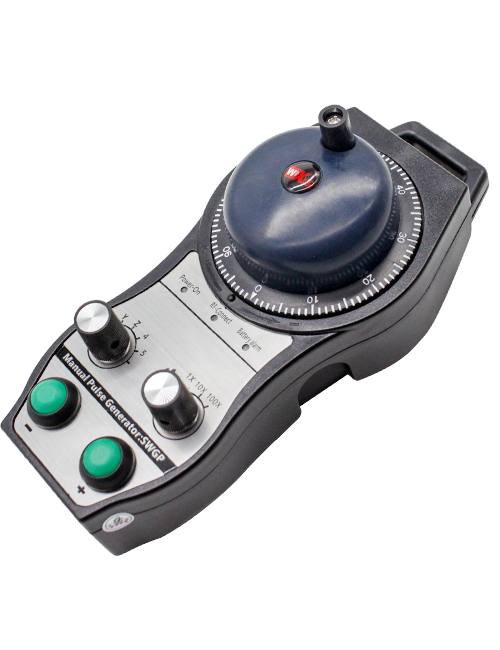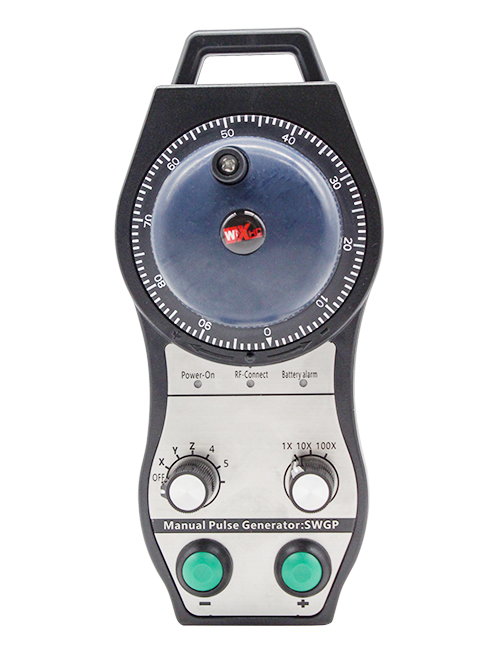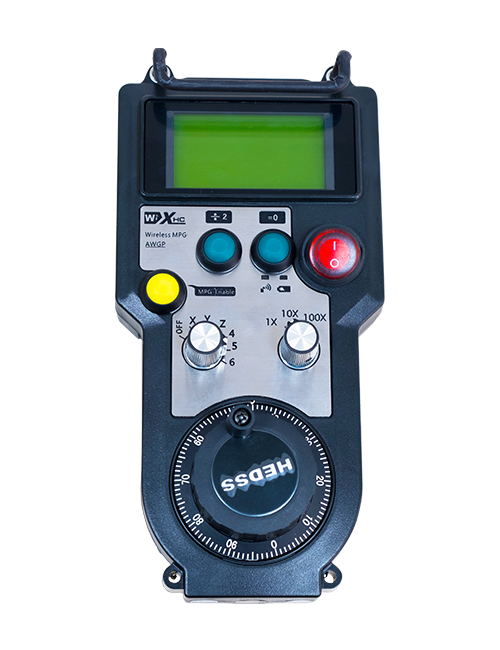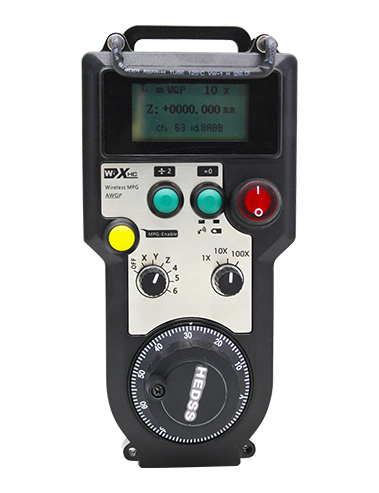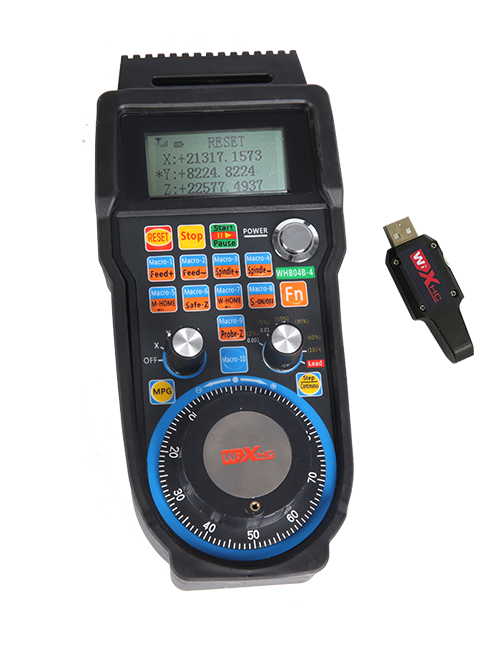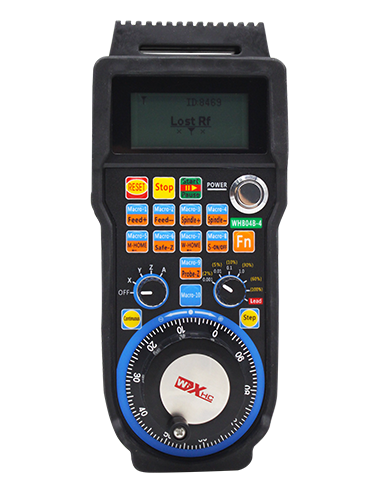Awọn ilana ti ko ni iyasọtọ fun awọn ilana iṣẹ Labẹ ti CNC inaro
Isapejuwe

1.Ifihan ọja
2. Awọn ẹya iṣẹ iṣẹ
| Operating voltage and current of wireless remote |
3V/14MA
|
| Battery specifications | 2 AA alkaline batteries, size 5 |
| Low voltage alarm range of wireless remote | < 2.3V |
| Receiver power supply voltage | DC5V-24V/A |
| Receiver emergency stop output load range | AC125V-1A/DC30V-2A |
| Receiver enable output load range |
AC125V-1A/DC30V-2A
|
| Receiver custom button output load range | DC24V/50mA |
| Receiver axis selection output load range | DC24V/50mA |
| Receiver magnification output load range | DC24V/50mA |
| Transmission power of handheld terminal |
15dBm
|
| Receiver receiving sensitivity | -100dBm |
| Wireless communication frequency | 433MHz frequency band |
| Wireless communication distance | Barrier free distance of 40 igun |
| Operation temperature | -25℃ < X < 55℃ |
| Anti fall height | 1 (mita) |
| Custom button quantity | 2 |


Awọn akọsilẹ:
① Pulse encoder:
Tẹ ki o mu bọtini ṣiṣẹ, shake the pulse encoder, emit a pulse signal,and control the movement ofthe machine axis.
② Enable button:
Press either enable button on either side, and the two sets of enable IO outputs on the receiver will conduct. Release the enable button to disconnect the enable IO output; And before switching the axis selection magnification and shaking the handwheel,the enable button needs to be held down to be effective; This function can be cancelled through configuration software.
③ Indicator lights:
Left side light: power on light,the handwheel uses the axis to select OFF for power on, and this light stays on after power on;
Middle light: a signal light that lights up when operating any function ofthe handwheel, and does not light up when there is no operation;
Right side light: Itaniji Itaniji Foltional, low battery level,this lightflashes or stays on, battery needs to be replaced.
④ Emergency stop button:
Tẹ bọtini iduro pajawiri, and the two sets of emergency stop IO outputs on the receiver will be disconnected, and all functions of the handwheel will be invalid.
⑤ Magnification switch:
Press and hold the enable button to switch the magnification switch, which can switch the magnification controlled by the handwheel.
⑥ Axis selection switch (yipada agbara):
Press and hold the enable button to switch the axis selection switch, which can switch the movement axis controlled by the handwheel. Switch this switch from OFF to any axis and turn on the handwheel power.
⑦ Custom button:
Two custom buttons, each corresponding to an IO output point on the receiver.

6.1 Awọn igbesẹ Ami ọja
1. Fi olugba sinu minisita itanna nipasẹ ipinnu naa lori ẹhin, tabi fi sinu minisita nipasẹ awọn iho dabaru ni igun mẹrẹrin ti olugba naa.
2. Tọka si aworan apanirun wa ki o ṣe afiwe rẹ pẹlu ohun elo lori-aaye rẹ. Connect the equipment to the receiver via cables.
3.After the receiver is properly fixed, eriali ti ni ipese pẹlu olugba gbọdọ wa ni asopọ, and the outer end of the antenna should be installed or placed outside the electrical cabinet. O ti wa ni niyanju lati gbe lọ si oke ti minisita itanna fun ipa ifihan agbara ti o dara julọ. It is prohibited to leave the antenna unconnected or place it inside the electrical cabinet, as this may result in the signal being unusable.
4. L'akotan, turn on the power switch of the handwheel, and you can operate the machine remotely using the handwheel.
6.2 Olugba awọn ifitonileti fifi sori ẹrọ

6.3 Olugba Wirgram Itọkasi Pipe

7. Awọn ilana isẹ ọja
1. Power on the machine and the receiver. The receiver’s working indicator light flashes. Install the battery in the wireless electronic handwheel, secure the battery cover, ati
turn on the power switch of the wireless electronic handwheel. The handwheel’s battery level indicator light is on.
2. Yan awọn ilana ipoidojuko: Tẹ ki o mu bọtini ṣiṣẹ, toggle the axis selection switch, and select the axis you want to operate.
3. Yan igbekun: Tẹ ki o mu bọtini ṣiṣẹ, toggle the magnification switch,and select the desired magnification level.
4. Igbese gbigbe: Tẹ ki o mu bọtini ṣiṣẹ, Yan yipada yiyan axis, select the magnification switch, and then rotate the pulse encoder. Rotate clockwise to move the
positive axis and counterclockwise to move the negative axis.
5. Tẹ ki o mu eyikeyi bọtini aṣa, and the corresponding button IO output of the receiver will be turned on. Release the button, and the output will be turned off.
6. Tẹ bọtini iduro pajawiri, the corresponding emergency stop IO output of the receiver will be disconnected, the handwheel function will be disabled,release the emergency stop button, the emergency stop IO output will be closed, and the handwheel function will be restored.
7. Ti o ba ti fi ọwọ ko ṣiṣẹ fun akoko kan, it will automatically enter sleep mode to reduce power consumption. Nigbati o ti lo lẹẹkansi, the handwheel can be activated by pressing the enable button.
8. Ti a ko lo fi ọwọ silẹ fun igba pipẹ, it is recommended to switch the handwheel shaft to the OFF position, Pa a agbara ọwọ, ati fa igbesi aye batiri.
8. Apejuwe awoṣe ọja

① :ZTWGP represents the appearance style
②:Purse awọn paramita:
01: Indicates that the pulse output signal is A, B; Pulsiot 30; pulse quantity 100PPR.
02:Indicating thatthe pulse output signals are A and B; Pulse voltage 12V; pulse quantity 100PPR.
03:Indicating thatthe pulse output signals are A, B, A -, B -; Pulsiot 30; pulse quantity 100PPR.
04:Tọkasi awọn iwọn Circuit kekere, pẹlu awọn ifihan agbara iyọ ti a ati b;The number of pulses is 100PPR.
05:Tọkasi orisun orisun orisun PNP giga-giga, pẹlu awọn ifihan agbara iyọ ti a ati b; The number of pulses is 100PPR.
③:Representing the number of axis selection switches, 2 duro fun 2 axes.
④:Represents the type of axis selection switch signal, Awọn aṣoju aṣoju-si-aaye abajade satelaiti, and B represents encoded output signal.
⑤:Represents the type of multiplication switch signal, Awọn aṣoju aṣoju-si-aaye abajade satelaiti, and B represents encoded output signal.
⑥:Represents the number of custom buttons, 2 duro fun 2 Awọn bọtini aṣa.
⑦:Represents the power supply for the system handwheel, ati 05 duro fun ipese agbara 5V.
⑧:L represents the left column (left knife holder), and R represents the right column (right knife holder).
9.Solution to Product Malfunctions

1. Jọwọ lo o ni agbegbe gbigbẹ ni iwọn otutu yara ati titẹ lati fa igbesi aye iṣẹ rẹ gbooro.
2. Jọwọ yago fun lilo ni awọn agbegbe ajeji gẹgẹ bi ojo ati awọn akara omi lati fa igbesi aye iṣẹ naa.
3. Jọwọ jẹ ki ifarahan ti ọwọ ti o di mimọ lati fa igbesi aye iṣẹ rẹ pọ si.
4. Jọwọ yago fun sisọ, ja bo, ijagun, patako ati bẹbẹ. to prevent damage to the precision components inside the handwheel or accuracy errors.
5. Ti ko ba lo fun igba pipẹ, Jọwọ fi ọwọ ni ọwọ ni ibi mimọ ati ailewu. Lakoko ibi ipamọ ati gbigbe, Ifarabalẹ yẹ ki o san si ọrinrin ati resistance igboro.
11. Alaye Aabo
1. Jọwọ ka awọn itọsọna naa ni pẹkipẹki ṣaaju lilo ati idiwọ ti kii ṣe awọn akosemose lati iṣiṣẹ.
2. Please replace the battery in a timely manner when the battery level is too low to avoid errors caused by insufficient battery power and inability to operate the handwheel.
3. Ti Tunṣe ba nilo, Jọwọ kan si olupese. Ti ibajẹ ba fa nipasẹ titunṣe ara, Olupese naa ko ni pese atilẹyin ọja
